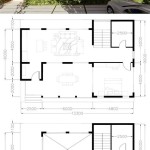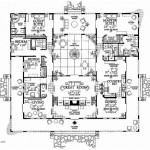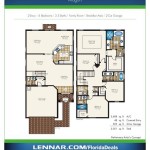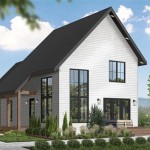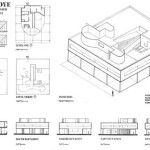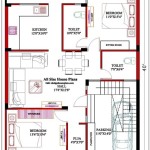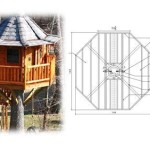Rear Attached Garage House Plans: Maximizing Space and Lifestyle
Rear attached garage house plans are gaining popularity for their ability to seamlessly integrate vehicular access with residential living spaces while maintaining a clean and aesthetically pleasing street presence. These designs position the garage at the back of the house, often accessed via a driveway along the side, creating a facade that can emphasize architectural details and landscaping. This configuration offers several advantages in terms of curb appeal, lot utilization, and interior layout flexibility. Unlike front-attached garages, which can dominate the front of a house, rear attached garages allow for a more welcoming and visually appealing entrance. This article will explore the key aspects of rear attached garage house plans, including their benefits, design considerations, and types.
Enhanced Curb Appeal and Front Yard Aesthetics
One of the primary benefits of rear attached garages is the significant improvement in curb appeal. Traditional front-attached garages often present a garage door as the focal point of the home's facade. This can detract from architectural details, landscaping, and the overall aesthetic impression. Conversely, a rear attached garage allows architects and designers to prioritize the visual appeal of the front of the house. The front facade can feature large windows, inviting porches, and intricate detailing, creating a more welcoming and attractive entry. Landscaping possibilities are also greatly enhanced. Without the need to accommodate a garage door and driveway directly in front of the house, homeowners can create lush gardens, walkways, and other landscaping features that enhance the property's beauty.
The strategic placement of the garage allows for a more cohesive and integrated architectural design. Building materials and design elements can flow seamlessly across the front facade without the interruption of a garage door. This results in a more harmonious and visually appealing home. Furthermore, this design choice often increases property value, as homes with greater curb appeal tend to command higher prices in the real estate market. The absence of a prominent garage door at the front allows for more creative design options, such as the incorporation of unique architectural styles and materials that might be compromised by the presence of a front-facing garage.
Many municipalities and homeowner associations have specific guidelines regarding the placement and visual impact of garages. Rear attached garages often comply more easily with these regulations, as they minimize the visual impact on the streetscape. By locating the garage at the rear, it becomes less obtrusive and blends more seamlessly with the surrounding landscape. This can streamline the approval process during construction and ensure compliance with local aesthetic standards.
Optimized Lot Utilization and Backyard Privacy
Rear attached garage house plans can contribute to better utilization of the overall lot space. By moving the garage to the back, more space is freed up for the front yard, potentially allowing for larger gardens, play areas, or expanded outdoor living spaces. This is especially beneficial on smaller lots where maximizing every square foot is crucial. In addition to the front yard benefits, rear attached garages often facilitate a more private and functional backyard. The garage can act as a buffer, shielding the backyard from street noise and creating a more secluded outdoor environment.
The location of the garage at the rear can be strategically integrated with other backyard features. For example, a breezeway or covered walkway can connect the garage to the main house, creating a sheltered transition during inclement weather. This area can also serve as an outdoor living space, blurring the lines between indoor and outdoor living. Furthermore, the garage itself can be designed with features such as a workshop, garden shed, or even an additional living space above, maximizing its utility and adding value to the property.
The driveway leading to the rear attached garage can also be designed to enhance the property's functionality and aesthetics. Rather than a large, paved area dominating the front of the house, the driveway can be narrower and more discreet, often running along the side of the property. This allows for more green space and landscaping features at the front. The driveway can also be constructed from permeable materials, reducing runoff and improving drainage. Careful planning of the driveway layout can significantly enhance the overall appeal and functionality of the property.
Flexible Interior Layouts and Functional Integration
Rear attached garages offer greater flexibility in terms of interior layout design. With the garage positioned at the back, architects have more freedom to design the interior spaces without being constrained by the need to directly connect to a front-facing garage. This can lead to more open and flowing floor plans, better natural light penetration, and improved overall functionality. The connection between the garage and the house can be designed to suit the homeowner's specific needs and preferences.
The transition space between the garage and the main house can be designed as a mudroom, laundry room, or even a home office. This allows for a seamless and functional integration of the garage into the living space. Mudrooms provide a convenient place to store shoes, coats, and other outdoor gear, helping to keep the rest of the house clean and organized. Laundry rooms located near the garage can streamline household chores and make it easier to transport laundry to and from vehicles. Home offices integrated near the garage can provide a quiet and convenient workspace, particularly useful for those who work from home or need a dedicated space for hobbies and projects.
In multi-story homes, the space above the rear attached garage can be utilized for additional living space, such as a guest suite, home theater, or bonus room. This can significantly increase the livable square footage of the house without expanding the overall footprint. Access to this additional space can be provided via a staircase inside the garage or through a separate entrance from the main house. The design of the space above the garage should be carefully considered to ensure it is well-insulated, properly ventilated, and aesthetically consistent with the rest of the home.
The placement of the garage in the rear can also influence the flow of traffic within the house. By strategically positioning the garage entrance, architects can create a more efficient and intuitive layout. For example, the garage might be located near the kitchen, making it easier to transport groceries and other items from the car. Alternatively, the garage might be positioned near a utility room, providing a convenient space for storing tools and equipment. The specific layout will depend on the homeowner's lifestyle and preferences, but rear attached garages offer the flexibility to tailor the interior spaces to meet those needs.
Moreover, security considerations can be addressed more effectively with a rear attached garage. The connection point between the garage and the house can be secured with appropriate locks and security systems, providing an additional layer of protection against intruders. The location of the garage at the rear also means that it is less visible from the street, reducing the risk of theft or vandalism. The overall security of the property can be enhanced by integrating the garage into a comprehensive security system that includes alarms, cameras, and motion detectors.
In summary, rear attached garage house plans offer a wealth of benefits in terms of curb appeal, lot utilization, and interior layout flexibility. By carefully considering the design and integration of the garage, homeowners can create a more beautiful, functional, and valuable property. The strategic placement of the garage at the rear allows for a more welcoming and aesthetically pleasing front facade, better utilization of lot space, and more opportunities for creating private and functional outdoor living areas. The interior layout can be tailored to meet the homeowner's specific needs and preferences, with the garage seamlessly integrated into the living space. When considering a new home construction or renovation project, rear attached garage house plans are a worthy option for maximizing space, lifestyle, and property value.

Rear Lane Access Home Designs G J Gardner Homes

The Arcadia Suits 12m Lot Rear Garage Perth Builder Switch Homes Narrow House Plans Cottage Floor

House Plans With Rear Entry Garages

Floor Plan Friday Narrow Block With Garage Rear Lane Access Lot House Plans Courtyard

Ot Cardel Homes Rear Facing Garage Hfboards Nhl Message Board And Forum For National Hockey League

House Plans With Rear Entry Garages

House Plans With Rear Entry Garages Or Alleyway Access

European Style With 4 Bed 5 Bath 3 Car Garage Monster House Plans Dream

House Plans With Rear Entry Garages

The Urban Courtyard Collection Rear Attached Garage Homes Pacesetter

